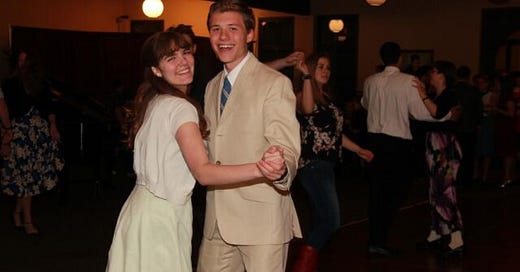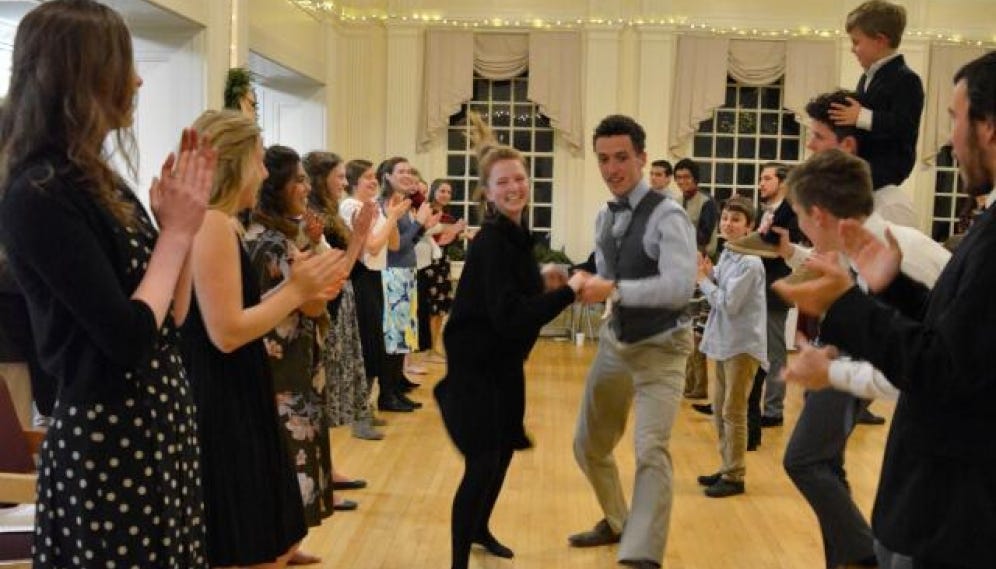Dancing as an Allegory of Catholic Marriage
Amid the debate over the morality of young people dancing together, here is an original take on the issue- done properly, dancing should be seen as the perfect activity for building strong marriages!
Recently, I’ve been hearing a bit about some online battles the pop up from time to time among Catholics, particularly those in trad circles, about the morality of dancing – specifically, dancing that involves physical touch. While the Church has no official position on dancing, there have been references made against the activity from various well-known Catholics. There have also been articles written, such as one from Tradition and Sanity, which make the case for dancing being supported by the Bible and by The Church.
This article will make no attempt to step into the middle of this ongoing fray.
Instead, I consulted my daughters to see if they had anything to say on this subject. My 19 year-old daughter Mary Amanda, had an interesting take. She sees partner dancing as being an allegory to Catholic marriage.
A Sacramental Serenade for Stronger Marriages
When dancing as partners, both the lead and the follower have distinct roles. If the follower attempts to lead, something undesirable is likely to occur. If the leader stops leading, chaos ensues. Strong, Catholic marriages are much the same. When a man is timid, or absent, or malformed as a spiritual leader, thus abdicating his vocation, the health of the marriage and family dynamic breaks down. Here, it’s important to point out something obvious to many, but an idea that is increasingly coming under attack – that husbands and wives are not interchangeable. Rather, each is irreplaceable.
Both in dancing and in marriage, the male takes the lead in deciding the steps and offers cues, and he trusts the female to respond accordingly. He has to be gentle, but strong. He looks out both for her safety and for the safety of the unit (so as not to run into other couples or external dangers). He also has to listen to the rhythm in order to maintain harmony and balance.
Conversely, the female follows those cues, trusts his instructions, and is flexible and receptive. She trusts him to catch her (literally and figuratively). When mistakes are made, she is patient with her partner, and helps him get it right as they move forward together.
In order to dance gracefully, the partners need practice to get it right. Marriage is similar. Ask a married couple in their first year or two of marriage if everything is going smoothly, and you will rarely get an adamant “Yes!” But a couple who’s had a lot of intentional and focused practice, including many toes getting stepped on, is much more likely to be able to rely on their spouse and trust each marital move to be performed “as one.”
So how does the “rhythm” come into play in marriage? The rhythm is God. If we’re not listening to God from one moment to the next, we will likely stumble – a lot. We’ll get off track and will eventually forget why we started “dancing” in the first place. If you’ve ever seen professional dancers at the top of their game, they move as one. It’s a beautiful thing to witness. That’s what being laser-focused on God at the center of a marriage can do. You might say that’s what “and the two become one flesh” looks like.
So, if you want to argue about dancing being an occasion of sin, maybe stop and think about how it instead might be an occasion of grace. There is potential for beauty here. Yes, that distinction requires virtue – development of the virtue of chastity, in particular. This is a virtue necessary not only for wholesome dancing, but for a truly healthy marriage. Striving for chastity is worth the effort, but is underappreciated by too many.
Ideally, this adherence to the rhythm and mutual trust, and striving for virtue should extend to the rest of the family, as well. On that note, I’ll end with a wonderful quote from the second article linked above, “Dancing can and should be done in families—and dances should be the kind that you wouldn’t blush to do before your own. As families are the building blocks of society, families that dance continue societies that dance. Dancing is a fun, healthy activity that creates happy memories within families, and therefore also in the societies threatened with becoming ever less like families.”
Photo Credits- all photos are from the various dances held at Thomas Aquinas College who according to Peter Kwasniesski are, “good, wholesome, innocent, and healthy" dances which are “exhibitions of good taste, social restraint, a ‘safe environment’ (as we’d say nowadays) for getting to know members of the opposite sex, and plenty of harmless fun and physical exercise.”








Wonderful reflection. Reminded me of Chance or Dance by Thomas Howard, which describes the Catholic faith as a kind of dance versus the chance universe of atheists.
It’s probably wise to keep out of the heated debates about dancing (I’ve been unfortunate enough to hear them back in my trad days) and consider the activity as an art form. Speaking as a teacher, I think dance rituals like Prom and Homecoming are going by the wayside, which makes me sad. There’re some lessons to be learned, like you bring up, about how to approach the opposite sex. It’s an important step to courtship and romantic relationships.
Without any formal dancing, I’m afraid you mostly just end up with twerking and grinding or no dancing at all.